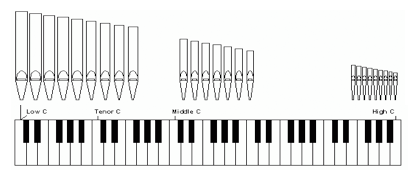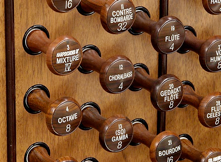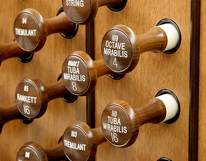Ranks: A rank of pipes is a set of pipes of a similar type or sound quality. Most organ keyboards have 61 keys, representing the C two octaves below middle C to the C three octaves above middle C. So a typical rank of pipes will contain 61 pipes, each connected to the corresponding key on the keyboard.

If the tallest pipe in this rank is 8 feet tall, it will have the frequency of about 64 Hz (cycles/second), corresponding to Low C on the piano. The pipe for the Tenor C (about 128 Hz) will be half as tall, at 4'. The pipe for Middle C (about 256 Hz) will be 2' tall and the pipe for High C (2,048 Hz) will be about 3 inches tall.
If the tallest pipe in the rank is 16' tall, the frequencies will be cut in half, or the key will play a note an octave lower. If the tallest pipe is 4' tall, the frequencies will double, or the corresponding key will play a note an octave higher.
Organ ranks are named according to the type of sound they produce. Each rank will also have a number associated with it, the height of the tallest pipe in the rank. Thus ranks will have names like 16 Montre or 8 Diapason or 4 Harmonic Flute. The sounds of the Montre and the Diapason (sometimes called the Principal) are unique to the pipe organ and is the sound which comes to mind in the context of traditional church music, such as hymns.

 Stops: In the Village Church organ, there are 30 ranks of pipes. Obviously, the organist will not want all the ranks to be played at the same time. The organist will control which ranks will be used by means of stop knobs on the console. For example, there is a stop knob labeled 16 Bourdon and another the 4 Flute. When a particular stop knob is pulled out, the rank associated with it will be available to be played. In the right photo, the rightmost two stop knobs are open.
Stops: In the Village Church organ, there are 30 ranks of pipes. Obviously, the organist will not want all the ranks to be played at the same time. The organist will control which ranks will be used by means of stop knobs on the console. For example, there is a stop knob labeled 16 Bourdon and another the 4 Flute. When a particular stop knob is pulled out, the rank associated with it will be available to be played. In the right photo, the rightmost two stop knobs are open.
